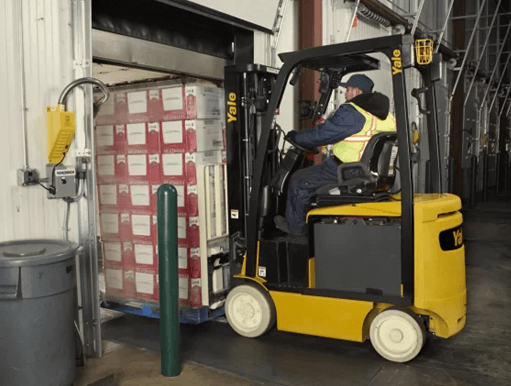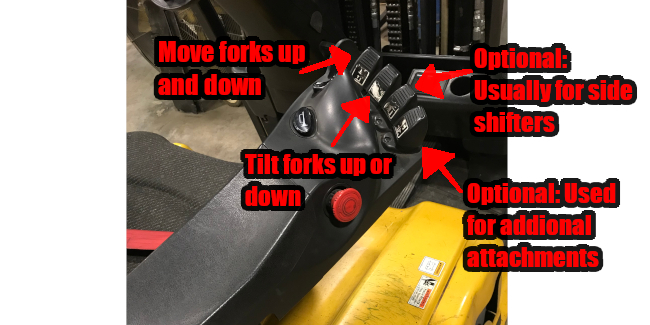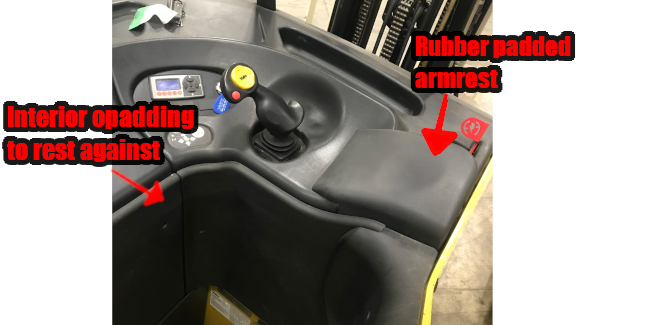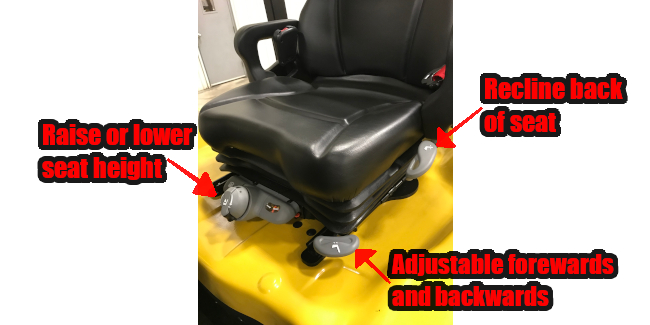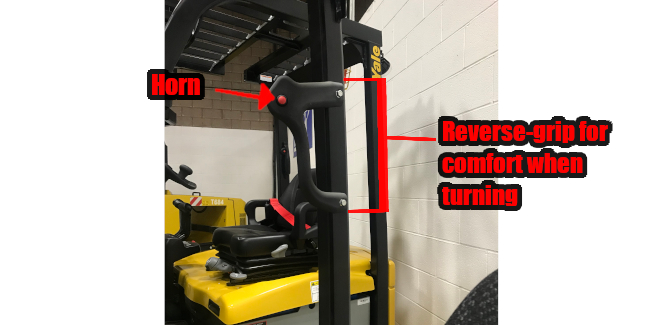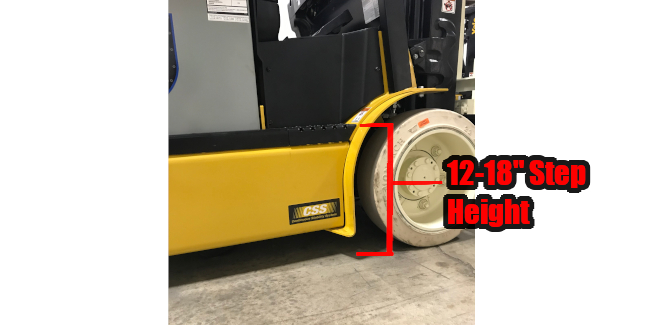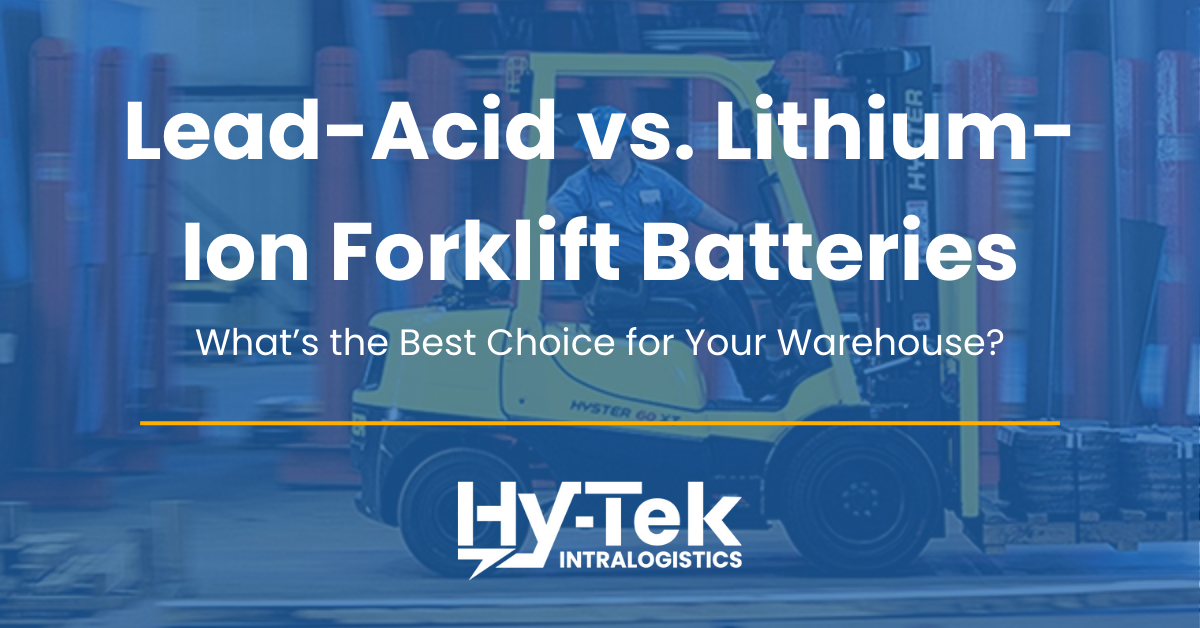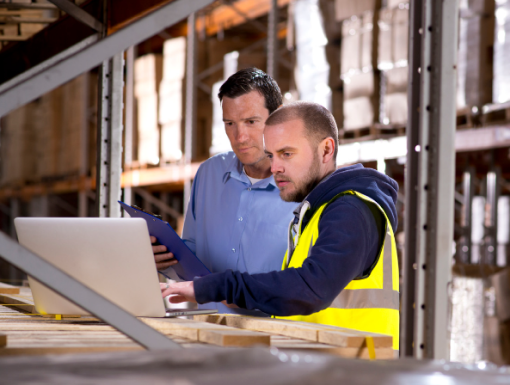Forklifts are categorized by their class, which ranges from 1 to 7.
Here we will only be focusing on class 1 forklifts, also known as electric counterbalanced trucks.
The term counterbalance means that the truck frame gains stability by having weight (usually a conventional battery, thin plate pure lead or a lithium-ion battery) towards the center or rear of the forklift.
View the Complete Class 1 to 5 Overview
Both of the 3-wheel and 4-wheel electric forklifts have options for cushion or pneumatic tires.
The 3-wheel electric forklift is ideal for indoor, smooth floor factory applications that require tighter spaces and a higher turn radius.
This is one reason why you see lower load capacities for the 3-wheel models.
Generally, the 3-wheel range for load capacity is 1,500 – 4,000 lbs.
While the 4-wheel electric forklift is more suitable for rough terrain and outdoor applications.
Thus, these models run higher in their load capacities, anywhere from 3,000 – 12,000 lbs.
Key Forklift Terms
The main features that determine how well a class 1 forklift works in your warehouse are:
- Load Capacity– How much weight the forklift can lift up and move.
- Lift Height– The maximum height (in inches) that a specific forklift model can lift. This varies based on the model and mast stages.
- Mast Stage– There are usually 3 levels of stage masts: 2-stage, 3-stage, and 4-stage.
- Max Travel Speed– Varies from 7 mph to 13 mph depending on the model. Stand-up forklifts travel the slowest.
- Battery Voltage– There are three types, 36V, 48V and 80V.
- Tires– Electric counterbalanced lift trucks use both cushion tires and pneumatic tires.
Forklift Battery Details & Options
The battery is the most expensive part of class 1 lift trucks, costing anywhere from $6,500 to $15,000 for a new forklift battery.
36V batteries are between $6,500-$14,800, whereas 80V batteries can cost anywhere from $9,900-$14,300.
It all depends on the size and how many amp-hours are needed.
Therefore, when making a decision on purchasing a new or used forklift you always want to get a high-quality battery with little to no prior use.
There are 2 main types of batteries: lithium-ion and lead-acid.
Battery Options
Option 1: Lead-Acid
The original, classic, old-faithful.
It has many names since it is the oldest type of battery.
While providing electricity is the main purpose of having one of these bad boys, it also serves as a weight to help balance your forklift when lifting heavy materials.
These batteries are much cheaper than lithium-ion or hydrogen fuel cell options but like many cases, you get what you pay for.
There are two kinds, thin-plate and tubular lead-acid batteries.
Thin-plates are a newer and more advanced battery when compared to tubular, with a higher upfront cost but longer run time, quicker charging and less maintenance.
High upkeep is required to keep tubular lead-acid batteries running well and charging times can shoot down your uptime.
If you are running one shift a day for 3-5 days a week this could be a good fit for you, it depends heavily on your application.
It all depends on the size and how many amp-hours are needed.
Therefore, when making a decision on purchasing a new or used forklift you always want to get a high-quality battery with little to no prior use.
There are 2 main types of batteries: lithium-ion and lead-acid.
Option 2: Lithium-Ion
The alternative and more expensive than lead-acid, lithium-ion batteries bring greater ROI due to extended battery lifespan (2-3X longer) and faster charge times.
These batteries are used most in warehouses that require a heavy workload on their fleet.
Lithium batteries provide operations managers the ability to utilize fast charging or opportunity charging and they do not experience as quick of a discharge rate over their lifespan.
Lastly, these batteries need very little charging space which frees up space for more SKUs or operations.
While the lithium-ion has clear advantages over the lead-acid battery, adding better safety and less maintenance to boot, the higher upfront cost deters many warehouses.
The top 10 Lithium-Ion Questions Answered
| BATTERY TYPE | BATTERY SIZE | NEW PRICE | USED PRICE |
|---|---|---|---|
| Lead-Acid | 36V | $6,500 – 14,800 | $3,900 – 8,900 |
| Lead-Acid | 48V | $6,500 – 15,000 | $3,900 – 9,000 |
| Lead-Acid | 80V | $9,900 – 14,300 | $5,900 – 8,500 |
Option 3: Hydrogen Fuel Cell
Hydrogen fuel cell batteries are a newer technology in the forklift industry.
I’m no scientist but after searching my best friend, Google I learned that they basically combine hydrogen fuel with oxygen to produce electricity.
Hydrogen fuel cells are used so corporations can target environmental safety, lower operating costs, and increase reliability.
Despite the perks, these batteries are not only expensive but they come with a very pricey installation/infrastructure overhaul.
In our current day, hydrogen can either be delivered to a customer location or generated on-site.
Delivery options range from gaseous hydrogen shipped via tube trailers for lower-volume usage or liquid state hydrogen for higher-volume applications.
The main advantages of hydrogen fuel cells are constant voltage fuel tanks until depletion, no performance degradation, no battery discharge, lower fuel emissions, and no battery swapping.
These all combine to save warehouses lost productivity and some sources say that applications can recognize a full ROI within as little as 2 years.
As I stated earlier, I am nowhere near an expert on chemical properties so if you’d like a deeper dive on the build-up and functions of a hydrogen fuel cell battery I would read this article by Battery University.
The best fits for hydrogen fuel cells are:
- Multi-shift operations that want to reduce downtime and increase efficiency
- Growing operations that need additional indoor space
- Organizations looking to lower their carbon footprint
- Confined settings that require high air quality for employee safety
Electric Forklift Features
Mast Types

There are three-mast types available for class 1 forklifts.
A 4-stage mast is not pictured above but is the exact same design with one more inner rail.
Your mast has a stationary outer rail with inner rails that slide with the help of chains to lift the forks and the backrest.
The more inner rails you have on your mast means your loads will have higher maximum lift heights.
Common names for each mast type:
- 2-Stage Mast or Duplex Mast
- 3-Stage Mast or Triplex Mast
- 4-Stage Mast or Quad Mast
Ergonomics
Manufacturers place operator comfort high on their priority list which makes sense as operators can spend 4-8 consecutive hours on a lift truck each shift.
Thus, the design among major forklift brands is for the most part exactly the same. The grab handles are located in similar spots, cup holders are built-in, spring-loaded seats adjust to the operator’s settings, etc.
Here we break down the main elements of class 1 forklifts where the design is intentionally modified for the end-user:
Mini Lever Controls
The directional system is placed at the fingertips of the operator’s hand.
It has the exact same function as standard hydraulic levers but is designed for less physical movement.
Floor Space
Built to provide operators with as much floor space as possible for free movement inside.
New models even have suspended floors that reduce up to 65% of shock and vibration.
Padding
Extra rubber padding along with the armrest on the stand-up 3-wheel models.
Padding is added around the entire inside frame of the stand-up model as well, providing operators with a cushion for leaning their knees or sides against.
Steering
An adjustable steering wheel that moves both up and down and forward and backward to position itself in the best spot for the operator.
Seat Features
A spring-loaded seat that can adjust up and down, backward and forwards, and back support.
Grip
A rear handle is attached to the back right or left structure bar on all class 1 sit-down models.
A horn button has recently been added to prevent turning all the way around when notifying other operators or bystanders that they are coming around a corner.
Steps
A 12-18″ bottom step (depending on the brand and model) to provide easy access to the lift truck.
The step is also placed high enough to prevent any tripping hazards.
Further Reading
FAQ
What is a Class 1 Forklift?
A class 1 forklift is an electric counterbalanced 3-wheel or 4-wheel lift truck that comes in both stand-up and sit-down models. They come with both cushion and pneumatic tires so they can be used indoors or outdoors within a temperature range of -30° to 113°.
How High Can a Counterbalance Forklift Go?
The lift height depends on the model and the mast type but the maximum height a class 1 forklift can reach is 283″ with a 4-stage mast.
How Much is Counterbalance Forklift Training?
Training for class 1 counterbalanced forklifts is offered online and in-person. Online courses cost as little as $59.95 from CertifyMe.net and OHSA’s website. In-person training classes are around $200 and are offered from several companies such as AsktheSafetyMan and Yale.

